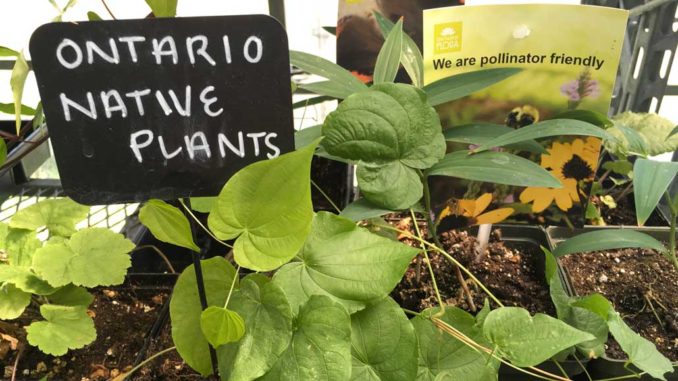
Every gardener in Leaside understands the challenges of gardening in the north. But climate change has given us more than just rising temperatures and strange seasons, it’s given us record-breaking extremes and weather events that are costly in so many ways, both environmentally and financially.
Back in March, I mentioned that Climate Change Gardens were identified as the number one garden trend for 2019. This got me thinking. Did Leaside gardeners embrace this trend?
Who better to ask than Carla Rose of Davenport Garden Centre on Bayview Ave. Her plant assortment is always inspiring and I’m personally drawn to her large selection of neonic-free plants (look for the blue containers), the organic herbs and vegetables, and this year, more pollinator plants including native Ontario.
According to Carla, there was a definite change in plant purchases this year and a shift in the way people thought about plants. Drought-tolerant plants were the biggest request, followed by pollinator plants. Green plants outsold colour, and almost daily, someone would ask specifically for Ontario native plants.
Sounds to me that Leaside gardeners are definitely embracing the trend, but are we doing enough? Would your garden pass my climate change test?
Could your garden survive a drought?
It won’t be long before we have water restrictions, which, with higher temperatures, could cause some of our favourite moisture-loving plants to suffer or even die. The climate change garden solution is to choose more drought-tolerant plants and make good use of rainwater by harvesting it and redirecting it to areas that need it most. If you greatly love a plant requiring an abundance of water, select a more efficient location. For example, hydrangeas in part sun need less water than those planted in full sun.
Could your garden survive a flood?
Flash floods are an increasing event and with so many aging storm sewers, our homes and gardens are at risk. Though many plants can recover from a short flood while plants are dormant, many cannot survive a warm weather flood. Consider some raised beds for plants that are succulents or require good drainage. Another solution is to create a rain garden and make good use of your garden’s flooded area. Most important, remember that many of our local native plants are hard-wired for both floods and droughts. Using more of them just makes sense.
Would a specific plant disease devastate your garden?
If you have mostly one type of plant material in your garden (monoculture) and if that plant were hit with a disease, what would your garden look like?
Mine would be a mess and this is my biggest Climate Change Garden fail because I have too many cedars. Even though a disease may never happen to them, a good climate change garden requires diversity in order to minimize risk.
I have some work to do to get my garden climate change ready and it’s mostly about adding some more native plants for greater diversity, introducing a few more raised garden beds, and slowly reducing my cedar supply.
We may never be able to design a garden with the same elegance and efficiency as Mother Nature does, but this is what we need to aim for. Climate change gardens do so much more than look pretty; these are gardens with a purpose that can help us and help the planet to restore itself.
That’s more than pretty…..that’s beautiful!
12 principles of Permaculture Design
Permaculture is a philosophy and design concept pioneered by Bill Mollison and David Holmgren in the late 1970s
In 2002, Holmgren wrote Permaculture: Principles and Pathways beyond Sustainability and listed these 12 principles of permaculture design.
1. Observe and interact: By taking time to engage with nature we can design solutions that suit our particular situation.
2. Catch and store energy: By developing systems that collect resources at peak abundance, we can use them in times of need.
3. Obtain a yield: Ensure that you are getting truly useful rewards as part of the work that you are doing.
4. Apply self-regulation and accept feedback: We need to discourage inappropriate activity to ensure that systems can continue to function well.
5. Use and value renewable resources and services: Make the best use of nature’s abundance to reduce our consumptive behavior and dependence on non-renewable resources.
6. Produce no waste: By valuing and making use of all the resources that are available to us, nothing goes to waste.
7. Design from patterns to details: By stepping back, we can observe patterns in nature and society. These can form the backbone of our designs, with the details filled in as we go.
8. Integrate rather than segregate: By putting the right thing in the right place, relationships develop between those things and they work together to support each other.
9. Use small and slow solutions: Small and slow systems are easier to maintain than big ones, making better use of local resources and producing more sustainable outcomes.
10. Use and value diversity: Diversity reduces vulnerability to a variety of threats and takes advantage of the unique nature of the environment in which it resides.
11. Use edges and value the marginal: The interface between things is where the most interesting events take place. These are often the most valuable, diverse and productive elements in the system.
12. Creatively use and respond to change: We can have a positive impact on inevitable change by carefully observing and then intervening at the right time.


